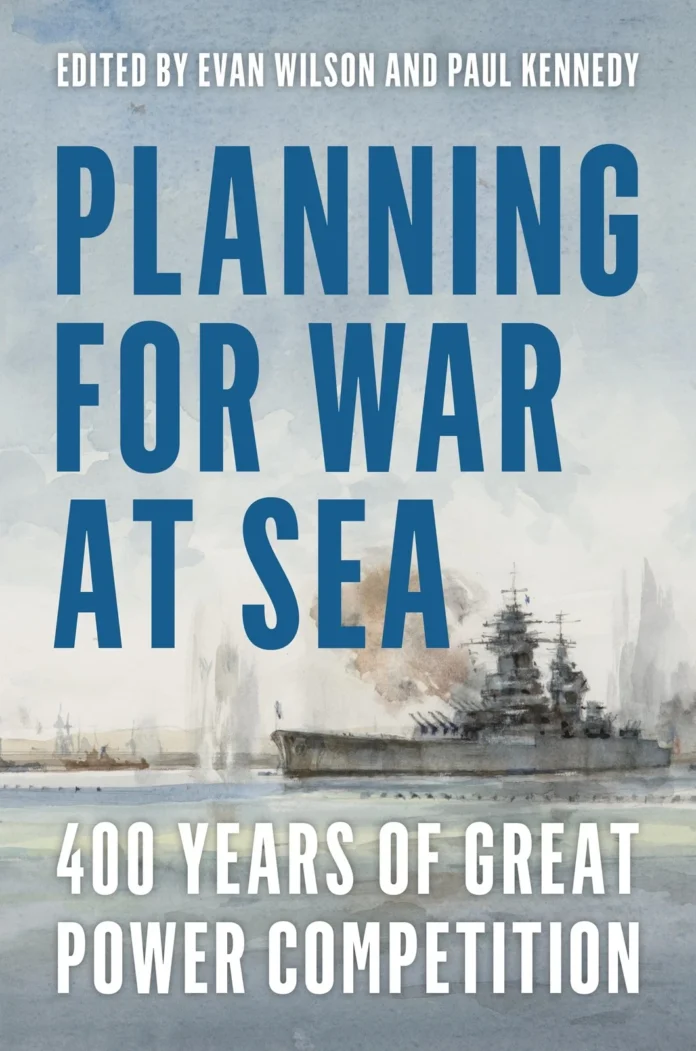
Planning for War at Sea; 400 Years of Great Power Competition. Evan Wilson and Paul Kennedy eds. Naval Institute Press, Annapolis, 2025.
Reviewed by Tim Coyle
‘No plan survives contact with the enemy’ is attributed to renowned military strategist Field Marshal Hemuth von Moltke in the 19th century. History is replete with examples of this truism and Planning for War at Sea provides 15 examples of major navies which either began maritime campaigns assuming one set of circumstances, only to find those circumstances radically changed during the war or planning for a war which never came. As such it is a valuable example of how history can inform contemporary naval strategy.
Written by respected naval historians, the 15 essays comprise:
‘The First Anglo-Dutch War, 1652 – 54; How an Unexpected Enemy with Innovative Tactics Started an Arms Race with Long Term Strategic Circumstances’;
‘What to Expect when You’re Expecting the French Revolution’;
‘A Mad Action – The Almost War between the United States and Morocco, 1801-3’;
‘Theory Meets the Reality of War – Julan S Corbett, His Theories, and the First World War’;
‘Contesting the German Island Chain – Winston Churchill and the Search for a Naval Offensive During the First World War’;
‘The Wars You Want Versus the Wars You Get – The Limitations of the Interwar US Navy as a Historical Model’;
‘Janus and Mars – French Naval and Defense Planning in the Interwar Years 1922-40’;
‘Admiral Nagano Osami and the Japanese Decision for War Against the United States’;
‘Which Adversary When? – The Strategic Dilemmas of the Royal Navy 1939-45’;
‘From Watchtower to Iceberg – Three Cases of Doctrinal Adaptation in the Pacific War, 1941-45’;
‘The Maritime Strategy’s Missing Middle’;
‘Deterrence or Escalation – A Reappraisal of the 1980s Maritime Strategy’;
‘Back to Its Comfort Zone – The Russian Navy’s Views of its Principal Adversaries, Strategy and Force Application, and Capacity Development’;
‘Adversaries and Planning Assumptions – China’s Navy and the Post Cold War World’;
‘Navies and Strategic Surprises; The Post Cold War US Navy.’
Certain fundamentals don’t change: the ability to adapt strategic and operational command thinking and materiel, logistic innovation and acceptance that there is no ‘silver bullet’ are constants (most ably currently demonstrated by Ukrainian forces). Reliance on ‘exquisite’ platforms delivered over years may well be subsumed in the short term by opposing strategies which may or may not have been identified in long-term defence planning.
The editors identify the constant factors of planning for war at sea as naval dispositions, the navies’ internal arrangements and the challenges facing decision-makers. They go on to rhetorically question whether the navy in question has identified the geographical outlines of a future conflict and have the fleets been configured accordingly. Is the command-and-control network secure, flexible and adaptable? Can the fleet defend itself and can early losses be replaced and battle damage repaired in a timely manner? Is the navy (and the wider community) psychologically prepared for personnel losses? Is the navy trained and able to expect the unexpected?
Naval history enthusiasts will be familiar with most of the campaigns discussed and the strategic, operational and tactical circumstances which changed the whole direction of the maritime campaigns. The book’s consistent theme emphasises that, despite the historical and materiel settings, circumstances will change during the campaign; however, the fundamentals of maritime warfighting do not.
Of note are the maritime campaigns which were not fought; primarily the 1980s US Maritime Strategy against the Soviet Union which never erupted into war and the French Navy’s dismemberment in 1940 despite achieving a high level of planning for war between 1922 and 1940. To plan against a national collapse was imponderable.
Of the 15 essays, Adversaries and Planning Assumptions; China’s Navy and the Post-Cold War World is particularly apposite. It discusses the contemporary maritime challenges in the Indo-Pacific and confrontation with a world-class navy, supported by an enormous paramilitary coastguard and a ‘grey zone’ asset in the Peoples Armed Police Maritime Militia ‘fishing fleet’.
Although the book’s essays concentrate on the major navies, the lessons to be learnt are not confined to those navies. The clear and present danger of the Russian Federation in the Baltic has seen the traditionally neutral Swedish and Finnish forces join NATO and, as a result, changing their planning to adapt to a formal alliance.
It is at this point of history and maritime planning that the scope must be expanded in that a purely ‘naval’ outlook is insufficient. Contingencies at sea now involve the active participation of joint and combined sea, air and land components. It also involves ‘soft power’, particularly diplomacy.
As commander of Central Command, General James Mattis told members of Congress at a National Security Advisory Council in 2017, “If you don’t fund the State Department fully, then I need to buy more ammunition.” Mattis believed that the enhanced funding directed to diplomacy and development reduced tensions and consequent risk of war.
Planning for War at Sea is a valuable compendium of naval planning over four centuries. It goes beyond cliches such as ‘preparing to fight the last war’ (although these do have relevance) into how navies reacted to wars that didn’t happen. Contemporary military joint warfare planners and civilian policymakers would benefit from the essayists’ analyses as background to their strategic formulations.



